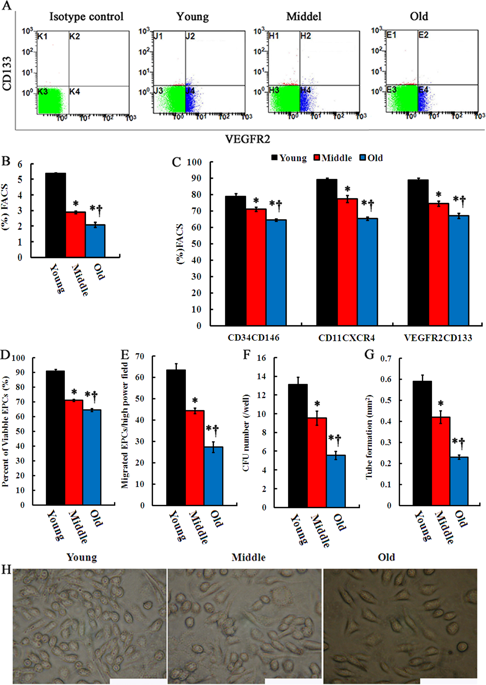Laboratory Investigation ( IF 5.1 ) Pub Date : 2019-07-10 , DOI: 10.1038/s41374-019-0290-1 Lan Zhao 1, 2 , Shaoheng Zhang 1, 3 , Jin Cui 1 , Weiguang Huang 1 , Jiahong Wang 3 , Feng Su 3 , Nannan Chen 3 , Qunlin Gong 3

|
Growth differentiation factor 11 (GDF11) is a transforming growth factor β superfamily member with a controversial role in rejuvenating old stem cells after acute injury in the elderly population. This study aimed to evaluate the effects of telomerase reverse transcriptase (TERT) on GDF11-mediated rejuvenation of senescent late-outgrowth endothelial progenitor cells (EPCs), defined as VEGFR2+/CD133+ cells, in elderly patients with acute myocardial infarction (AMI). We compared the quantity and capabilities of VEGFR2+/CD133+ cells from old (>60 years), middle-aged (45–60 years), and young (<45 years) AMI patients. The decline in circulating count and survival of VEGFR2+/CD133+ cells with age was accompanied by decrease in their TERT and GDF11 expression levels in patients with AMI. Further, upregulation of TERT could trigger GDF11-mediated rejuvenation of old VEGFR2+/CD133+ cells by renewing their survival and angiogenic abilities through activation of canonical (Smad2/3) and noncanonical (eNOS) signaling pathways. Depletion of GDF11 or TERT caused senescence of young VEGFR2+/CD133+ cells leading to impaired vascular function and angiogenesis in vitro and in vivo, whereas adTERT and rhGDF11 rescued this senescence. TERT cooperates with GDF11 to enhance regenerative capabilities of old VEGFR2+/CD133+ cells. When combined with TERT, GDF11 may represent a potential therapeutic target for the treatment of elderly patients with MI.
中文翻译:

TERT 协助 GDF11 使老年心肌梗死患者衰老的 VEGFR2+/CD133+ 细胞恢复活力。
生长分化因子 11 (GDF11) 是一种转化生长因子 β 超家族成员,在老年人群急性损伤后恢复旧干细胞方面的作用存在争议。本研究旨在评估端粒酶逆转录酶 (TERT) 对老年急性心肌梗死 (AMI) 患者中GDF11 介导的衰老晚期生长内皮祖细胞 (EPC)(定义为 VEGFR2 + /CD133 + 细胞)再生的影响. 我们比较了老年(>60 岁)、中年(45-60 岁)和年轻(<45 岁)AMI 患者的VEGFR2 + /CD133 +细胞的数量和能力。VEGFR2 + /CD133 +的循环计数和存活率下降随着年龄的增长,AMI 患者的 TERT 和 GDF11 表达水平下降。此外,TERT 的上调可以通过激活经典 (Smad2/3) 和非经典 (eNOS) 信号通路来更新它们的存活和血管生成能力,从而触发GDF11 介导的旧 VEGFR2 + /CD133 +细胞再生。GDF11 或 TERT 的耗竭导致年轻的 VEGFR2 + /CD133 +细胞衰老,导致体外和体内血管功能和血管生成受损,而 adTERT 和 rhGDF11 挽救了这种衰老。TERT与GDF11合作增强老旧VEGFR2 + /CD133 +的再生能力细胞。当与 TERT 联合使用时,GDF11 可能代表治疗老年心梗患者的潜在治疗靶点。











































 京公网安备 11010802027423号
京公网安备 11010802027423号